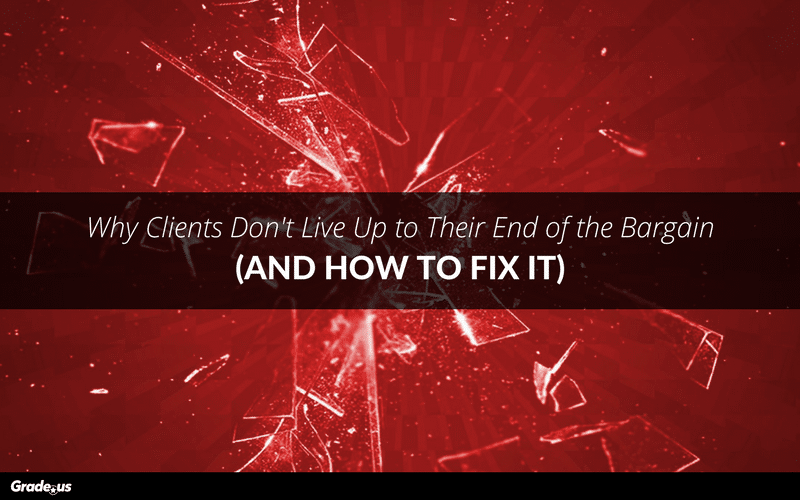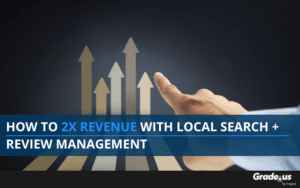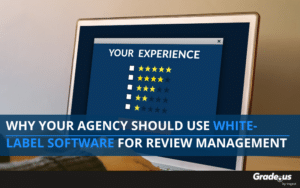They’re refusing to help you.
Your clients have hired you to help their business. They’ve paid for your services and signed on the dotted line. But they’re refusing to do what you’ve asked.
They won’t give you the feedback you’re asking for. They drag their feet on getting you the materials you need to do an amazing job for them. Almost immediately, it seems like they’re actually trying to sabotage their project. It’s as if they’re trying to lose money.
What’s going on?
Why is it that some clients refuse to live up to their end of the bargain?
Credibility.
Low credibility starts the client relationship off on the wrong foot
Clients enter into a relationship with you with perceptions. These perceptions dictate how they see you and shapes how they’ll behave. BJ Fogg, researcher at Stanford’s Persuasive Technology Lab, stated there are four kinds of credibility.
1. Earned credibility. This is the kind of credibility you develop with clients who had a positive experience with you. Your customer service is excellent, you provide expert advice and you produce results.
2. Reputed credibility. Hundreds of positive reviews. A referral from an unbiased client whose experience has been positive. They’re pleased with your service so they decide to spread the word. They mention your agency to family, friends and acquaintances – anyone who’s in the market for your service.
3. Presumed credibility. This is all about familiarity and assumptions. A client sees your advertising salvo on YouTube, Facebook or LinkedIn. “I saw your interview on Business Insider and your guest posts on Forbes.” These clients develop a general familiarity with your brand. A brand they’ve heard of is more credible than one they haven’t.
4. Surface credibility. This refers to a client’s subjective opinion of your agency, brand or service (they’re in-demand, top notch service, they always get results, I think they’re trustworthy, etc.). A client looks at your business, takes stock of what they see and makes a judgment call.
To take things further, each credibility sub-type operates on a continuum. The further you are on the continuum, the more credible organization appears to be.
At least in your client’s mind.
This is incredibly important because agency clients sort the organizations they work with into groups. This sorting process is largely subconscious, it would be presumptuous to assume clients are making these decisions consciously. Here’s why this sorting process is so important.
It sets the tone of your relationship.
The solution? Build credibility in all four areas. Build a strong online review profile, get testimonials from clients, create a website and marketing campaign. Do what it takes to create a reputation that demonstrates authority and credibility.
Why go to the trouble?
Your credibility is a measurement of trust. The more credible you appear to be, the easier it is for clients to trust you. Agency clients are looking for a way to establish a kind of relational hierarchy. They’re looking to answer two very specific questions.
1. Do I need them more than they need me? Any agency that’s prominent, well received, with good standing in the marketplace has power. These agencies are great at what they do and they’re great at communicating their value. Clients approaching these agencies realize it’s an honor to be selected by these agencies. They’re usually on their best behavior.
2. Do they need me more than I need them? Agencies in this category are seen as less credible, though many of them are able to run circles around their more well-known competitors. Clients don’t know enough about the industry to be able to tell these agencies apart. So they go with the metrics they’re familiar with, price, product and service. Agencies in this category chase after clients, amplifying a prospect’s subconscious disdain.
Clients in the second category tend to misbehave.
These clients make one off demands. They’re often uncooperative, difficult to work with and even more difficult to please. Let’s say you’re an agency with clients in the second category…
Does this mean you’re stuck with uncooperative clients?
Not at all.
It means you’ll need to make some changes. Make the right changes and you’ll notice something. A radical transformation in your client’s attitude and behavior.
Here’s how you do it.
1. Don’t treat your clients like adults.
This sounds insane doesn’t it?
“They’re adults, why shouldn’t I treat them that way? Are you saying I should treat them like kids?”
No, I’m suggesting instead that you treat your clients like professionals. Professionals are proactive. They aren’t begged or chased down to fulfill their end of the deal. They won’t need to be told to act in their best interest. Professionals are available and cooperative.
They’re on top of their work.
They’re socially competent A-players who do what needs to be done.
Get clients to live up to their end of the bargain.
Avoid chasing after clients; when you beg, cajole or harass them to keep their end of the deal you create harm.
· Stop chasing after clients and endlessly repeating yourself. This steadily decreases a client’s respect and admiration for you.
· Require clients to earn your attention. Give your clients the benefit of the doubt, do what you can to establish and maintain goodwill. But within that framework of goodwill, expect clients to earn your attention. If they give you what you need to continue working on their project, your project has their attention. If they neglect their project, place them on hold.
· Expect reciprocation. When you invest something, anything in your client’s project, expect something in return. If they ask for a proposal, ask them to set a time to go over the proposal together. If you give them a deliverable, expect feedback and engagement re: said deliverable. If they want you to start, expect a deposit.
Here’s the key differentiator: when it comes to the relationship – how you treat them, kindness, respect, etc. – give without expectation.
2. Let clients choose whatever they want.
When a client believes they need me more than I need them they can fall into a trap. The trap of believing they have the right to choose whatever they want. And you know what?
They’re right.
Here’s why that’s a problem. When agencies accept that lie, they enable unprofessional behavior. Most agencies don’t allow their client to experience the natural consequences of their choices, they take the fall.
What does that looks like?
Let’s say you’re working within a deadline. Client pays their deposit, gives you what you need to get started, and then without warning they stop responding.
If you’re like most agencies, you call the client repeatedly.
You nag, beg, and sometimes even whine. Anything to get your client to respond, which only increases their resistance.
Then, all of a sudden, your client returns.
They dump a large pile of work in your lap exclaiming “I’m in a bind and I need this done by 8PM tonight!” What do most agencies do? They give in, they force their employees to stay late. They neglect their other clients, and they do whatever it takes to get things done.
Their dysfunctional client seems happy at the moment.
But at what cost?
Their other clients are unhappy, employees are burned out and morale has dropped. Agency work quality suffers as a result.
Get clients to live up to their end of the bargain.
Clients should be free to do what they want, provided that they’re willing to accept the consequences. If your client chooses to blow you off you can reach out them with friendly reminders.
Let’s say you’re dealing with an unresponsive client. How would you approach them? Like this:
Hi Jan,I’m sure you’ve just been busy, but I wanted to quickly check that you received the reports I sent last week.
Here are the changes you wanted to see written up:
[deliverables]
I’ve attached it again to saving you digging around in old emails. We’ll need your feedback to get started on this next phase.
Please let me know.
Best,
Andrew McDermott
Nothing about that communication was rude, aggressive or unprofessional. Well, what if they continue to blow you off? Give them the benefit of the doubt and you follow up with them.
Hi Jan,Have you given up on this project? I’ve kept a slot open in our schedule for your project. If you’ve decided to take things in a different direction that’s no problem.
Please let me know.
Warmly,
Andrew McDermott
What if you’ve followed up repeatedly and they still fail to keep their end of the deal? You give them the consequences of their choice.
Hi Jan,I haven’t heard back from you re: your project, so I have to assume your priorities have changed. We’ve placed your project/campaign on hold.
Please let us know if we can be of any help in the future.
Best,
Andrew McDermott
Would it be unwise to drop all of your other clients when your dysfunctional client returns with an emergency? Absolutely. A better idea? Have your dysfunctional client earn their way back into your schedule by completing your most recent request.
3. Let clients do whatever they want.
The vast majority of agencies struggle with a hidden problem. They try to control their clients. Not intentionally of course.
If a client refuses to cooperate, we do everything in our power to get them back on track. We do our best to get clients to do what we want them to do. And you know what? That’s understandable. What we’re asking for is, for the most part, pretty reasonable.
Give us what we need to do our jobs.
That’s not at all unreasonable, but it’s still a problem. Why? Because we’re too focused on the outcome we want. Here’s the hidden cause of our problem. We’re too focused on our dysfunctional clients.
But why?
Our sales funnel is empty or depleted. It’s common for agencies to go through feast and famine periods. When it’s good, it’s really good. You’re flooded with work, clients are spending money, they’re engaged – life is good. When it’s bad, it’s really bad. You’re out of work, clients aren’t calling, you’ve got nothing in the pipeline.
When you’re in a bad spot and you only have one or two prospects in the pipeline it’s tough to be objective.
Get clients to live up to their end of the bargain.
Clients aren’t going to ask for permission, they’re going to do what they want to do anyway. You need the ability to do the same.
How do you gain that ability? You keep your funnel full of customers.
That leads us to another dirty secret doesn’t it? Many agencies don’t know how to keep their sales funnel full of qualified prospects! It’s the embarrassing secret many agencies would do their best to avoid discussing.
But it’s true.
If you’re unsure, you do the smart thing. You learn from experts, who’ve built and sold agencies. What if you know how to fill your pipeline but you simply don’t have the time?
You make time.
You do what it takes to fill your funnel and keep it full. Maybe it ‘s guest posting on high traffic and industry recognized sites. Could be a Facebook ad campaign or advertising on Google’s Display Network.
The point is you’re focused on keeping your funnel full.
This gives you leverage, power and the ability to say No. That’s important, because it frees you from a power hungry prospect. Instead of accepting work from a client who refuses to cooperate, you have the power to move on.
Because there are 20 to 30 prospective clients waiting in your inbox.
Your clients need you more than you need them
The vast majority of clients don’t realize they need you more than you need them. Your expertise isn’t something that can be bought.
Cajoling and chasing clients doesn’t work.
Your clients have the freedom to choose, to make their own decisions. Your agency needs the freedom to do the same. You need the freedom to walk away.
Your ability to walk away keeps clients engaged.
It sends the message you need me, more than I need you, believe it or not that’s appealing to clients. But it’s also beneficial. It enables you to approach your clients as an equal. To work with them with the full understanding that both you and your clients can walk away.
It moves your relationship to healthier place.
The agency/client relationship is beneficial to both parties because both of you choose to work together.
When you choose clients, they choose to behave
Most agencies accept new clients. They need to pay the bills so they accept the clients they’d prefer to avoid.
Their clients know.
It’s the reason they fail to keep their end of the bargain. It doesn’t have to be that way for you. With credibility and freedom comes the ability to say No, to expect and receive the behavior you want. Clients will keep their end of the bargain if the right environment is in place.
Give your agency the credibility and freedom it needs to attract the right clients. You’ll find refusal becomes a thing of the past.
About the Author
Andrew McDermott
Andrew McDermott is the co-founder of HooktoWin. He shows entrepreneurs how to attract and win new customers.









